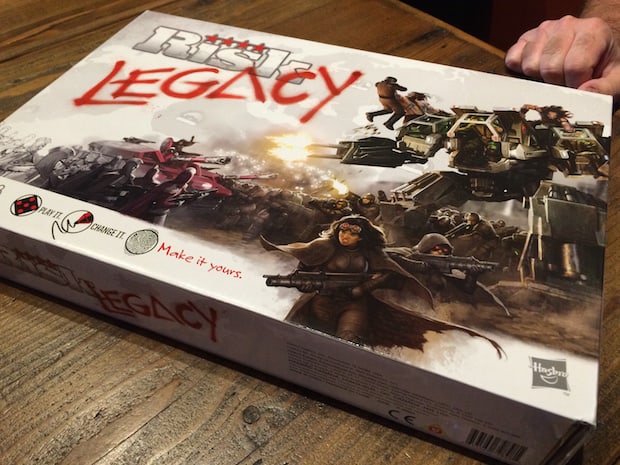
RISK LEGACY IS A GAME THAT YOU PERMANENTLY CHANGE AS YOU PLAY IT
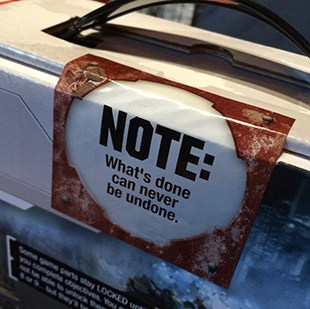
The basic gameplay is Risk (amass armies and resolve combat with dice) but with a victory point ending condition that allows the game to end in closer to an hour rather than six. Each time you play there are opportunities to change the board, the cards or the rules. These are meant to be (mostly) irreversible, permanent changes that likely result in your copy of the game being unique. Additionally, an air of mystery surrounds the changes since they are sealed in envelopes with instructions on the outside of when to open them (including one labeled “Do Not Open, Ever!”).
I was intrigued by the Legacy mechanic as soon as I heard about it. While the idea of marking up the game and destroying some of the cards gave me pause, the allure of an evolving game was strong. The problem was that the game needed to be played by a core set of players many times, and I just don’t have the regular game group situation that would allow for that. As time passed more games were announced that would be using the Legacy mechanic, and my desire to play Risk Legacy swelled.
The answer to my problem, it dawned on me, was to do a marathon session. While circumstances make it hard to play the same game with the same people for 2 hours a week over successive weeks, I could find a 12 hour stretch to play as many sessions as possible. I talked to fellow leaguer Peter Vaughan and he was on board, and we soon had two more intrepid players, as Doug Eboch and Ta-Te Wu agreed to join us.

PIE & SPOILERS
Let me pause here a moment to discuss the importance of pie. When the Saharan Republic wipes the last traces of your Khan Industries forces from the map and you have limited time to mourn the loss before you need to move on to then next game, you need pie. Flaky crust with sweet filling is necessary and is one of the reasons we chose to hold the marathon at the Game Haus Cafe.
Let me extend the previous pause momentarily and talk about spoilers. There will be mild spoilers in the following paragraphs. If you want all the secrets of the game to remain shrouded in mystery you should stop now and watch this video of a porcupine eating a pumpkin instead.
THE GAME
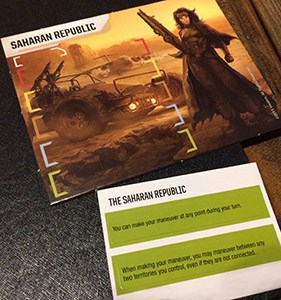
When you unseal the box for Risk Legacy and prepare for your first game you jump into customization right away. Each of the five factions has two possible starting powers and you must decide to accept one and destroy the other. The unused powers will never see the light of day in your version of the game. Also, you get to increase the value of some of the territory cards (there’s one card for each territory on the map board) by adding 12 coin stickers to them. Finally, at the start of each game, provided there are enough to go around, players get to add scars (adding/subtracting from defender rolls) to the map board.
Already, before your first game is played, your copy is likely unique.
At the end of the first game there will be winners and losers, and some may have even been eliminated. Winners get to do things like name continents (picking up a bonus in future games), found major cities or destroy territory cards. Losers get to found a minor city or enhance a territory card. Those who were eliminated receive no spoils. Players sign the board when they win and sign the back of the faction they played, noting their starting territory and win/loss/elimination result. Going into subsequent games, players who have signed the board (i.e. won) get missiles which can alter die rolls, whereas the other players start with one victory point.
The rules and gameplay change when you hit certain milestones that trigger the opening of sealed packets. [Note: Here’s where those spoilers come in – the porcupine video is still available if you want to maintain secrecy] When one player had won for a second time Homelands were introduced that gave each faction an advantage for continent they had started in most often in previous games. This packet also added event and mission cards, increasing the importance of cities and adding additional ways to earn victory points.
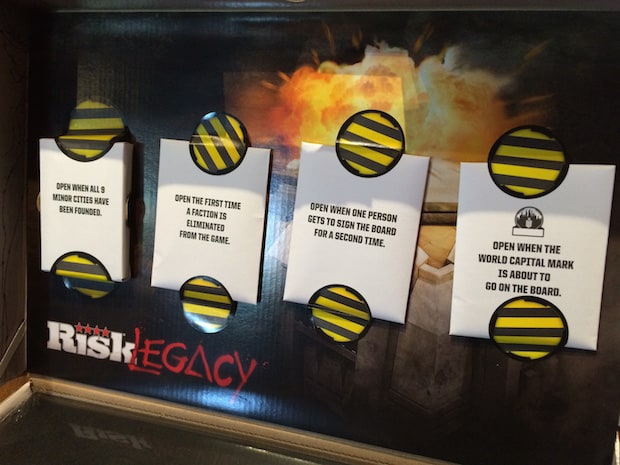
Another packet triggered when the ninth minor city had been placed on the board and added drafting to the setup rules. Now, instead of just picking a faction, players also take turns choosing their initial resources, turn order and placement order. The last packet that we triggered in our marathon was when a faction was eliminated (all armies removed from the board with no opportunity to re-emerge) and it allowed eliminated factions to gain a unique “Comeback Power”.
In our marathon we finished six games of Risk Legacy and would have played more if the cafe wasn’t closing up for the night. We opened half of the secret packets, made our marks on the map board and established a history for our factions. While there is much more to explore in the game there are some features of the design that stand out already.
OWNERSHIP
Signing your names to the boards and factions, permanently changing the map and components, and keeping track of the history of the games all contribute towards a strong feeling of ownership over this game — specifically your particular copy of this game. Your games of Risk Legacy, much like a D&D campaign, are going to work best with the same group of players, those who are invested in how this world came to be the way it is. If you brought in a new player at game seven they’d be able to pick it up – could even win – but the experience wouldn’t be as meaningful to them.
BALANCE
Your fourth game of Risk Legacy is probably one that was never play-tested. You’ve made decisions about faction powers, scar locations and territory resources that probably make your copy unique. This could lead to some sort of imbalance in the game – continents that are dramatically superior/inferior or factions that are better/worse. The addition of drafting the starting conditions, and adding comeback powers to eliminated factions help to rebalance things. In addition, the practice of every player adding scars to the map at the start of every game allows the players to course correct the map based on previous experience.
PROGRESSION
I would not have spent a day playing regular Risk over and over, yet I was happy to play Risk Legacy six times in a row. Every game we played had the possibility of exposing some previously unseen part of the design – a new event card, the first use of a faction power or the triggering of an entirely new mechanic or rule section. The draw to open new packets and explore is so strong that players are tempted to ignore their own best interests in the hopes of triggering some of the packet conditions (e.g. “three missiles are used in the same combat roll”).
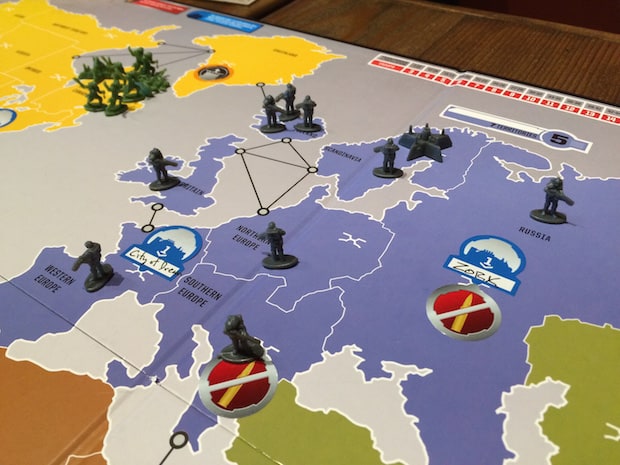
I want to get back to Risk Legacy soon with the same group and see what happens next in the world we made. It’s an intriguing way to evolve a game and engage players, and I’m anxious to see how the Legacy system works in upcoming games like Seafall and Pandemic Legacy. I’m just not sure how I’m going to get time for all the marathon sessions I’ll need.






